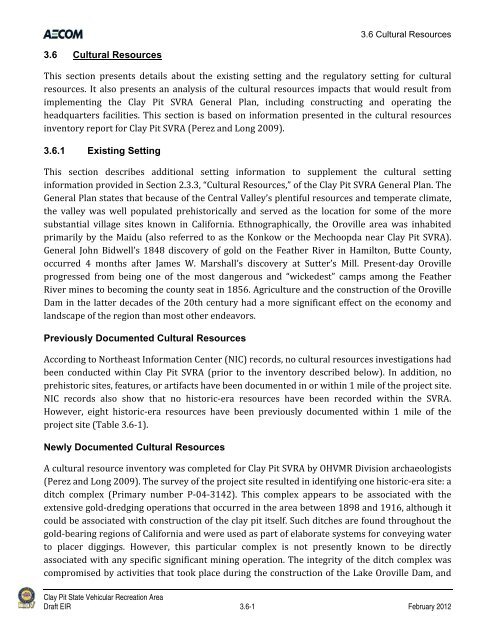Draft Environmental Impact Report - California Off Highway Vehicle ...
Draft Environmental Impact Report - California Off Highway Vehicle ...
Draft Environmental Impact Report - California Off Highway Vehicle ...
You also want an ePaper? Increase the reach of your titles
YUMPU automatically turns print PDFs into web optimized ePapers that Google loves.
3.6 Cultural Resources<br />
3.6 Cultural Resources<br />
This section presents details about the existing setting and the regulatory setting for cultural<br />
resources. It also presents an analysis of the cultural resources impacts that would result from<br />
implementing the Clay Pit SVRA General Plan, including constructing and operating the<br />
headquarters facilities. This section is based on information presented in the cultural resources<br />
inventory report for Clay Pit SVRA (Perez and Long 2009).<br />
3.6.1 Existing Setting<br />
This section describes additional setting information to supplement the cultural setting<br />
information provided in Section 2.3.3, “Cultural Resources,” of the Clay Pit SVRA General Plan. The<br />
General Plan states that because of the Central Valley’s plentiful resources and temperate climate,<br />
the valley was well populated prehistorically and served as the location for some of the more<br />
substantial village sites known in <strong>California</strong>. Ethnographically, the Oroville area was inhabited<br />
primarily by the Maidu (also referred to as the Konkow or the Mechoopda near Clay Pit SVRA).<br />
General John Bidwell’s 1848 discovery of gold on the Feather River in Hamilton, Butte County,<br />
occurred 4 months after James W. Marshall’s discovery at Sutter’s Mill. Present‐day Oroville<br />
progressed from being one of the most dangerous and “wickedest” camps among the Feather<br />
River mines to becoming the county seat in 1856. Agriculture and the construction of the Oroville<br />
Dam in the latter decades of the 20th century had a more significant effect on the economy and<br />
landscape of the region than most other endeavors.<br />
Previously Documented Cultural Resources<br />
According to Northeast Information Center (NIC) records, no cultural resources investigations had<br />
been conducted within Clay Pit SVRA (prior to the inventory described below). In addition, no<br />
prehistoric sites, features, or artifacts have been documented in or within 1 mile of the project site.<br />
NIC records also show that no historic‐era resources have been recorded within the SVRA.<br />
However, eight historic‐era resources have been previously documented within 1 mile of the<br />
project site (Table 3.6‐1).<br />
Newly Documented Cultural Resources<br />
A cultural resource inventory was completed for Clay Pit SVRA by OHVMR Division archaeologists<br />
(Perez and Long 2009). The survey of the project site resulted in identifying one historic‐era site: a<br />
ditch complex (Primary number P‐04‐3142). This complex appears to be associated with the<br />
extensive gold‐dredging operations that occurred in the area between 1898 and 1916, although it<br />
could be associated with construction of the clay pit itself. Such ditches are found throughout the<br />
gold‐bearing regions of <strong>California</strong> and were used as part of elaborate systems for conveying water<br />
to placer diggings. However, this particular complex is not presently known to be directly<br />
associated with any specific significant mining operation. The integrity of the ditch complex was<br />
compromised by activities that took place during the construction of the Lake Oroville Dam, and<br />
Clay Pit State Vehicular Recreation Area<br />
<strong>Draft</strong> EIR 3.6-1 February 2012








